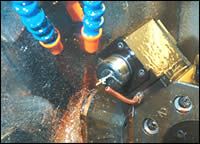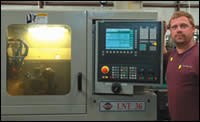CNC Maximizes Machining Efficiency
Siemens' Sinumerik 840D control allows this shop to run its machines virtually glitch-free.
Share




As just about any machine shop will tell you, achieving 100-percent run time is impossible. But the key to effective production is to approach that elusive figure as a goal, says Al Feldman, one of Alan Manufacturing Inc.’s two operators. New machines with sophisticated controls helped the production CNC turning shop come closer to that goal than it ever thought possible.
“We are not running 100 percent statistically speaking,” Mr. Feldman explains. “However, we are closer than we would have dreamed years ago. We are aggressively approaching that goal because the equipment keeps running all day, every day.”
“We’ve targeted a customer product range and a production strategy that allows us to use the machine tools we have in-house in the most efficient manner,” Mr. Feldman says. “For example, we can use a 1/16-inch groove tool to perform single or multiple cuts on almost every job. The setups are easier.”
Based in Odessa, Florida, Alan Manufacturing has provided various local manufacturers with quality components since it opened in 1976. These components include parts used in the production of high-accuracy flow instruments, high-pressure hydraulic gear, surgical equipment, marine engines and military devices.
To machine these components from barstock, the shop performs turning, threading, boring, drilling, cross-drilling and milling operations. Post-heat-treat operations include grinding, honing and hard machining to 0.00005-inch roundness. The company typically works with materials such as 1141 steel and naval brass, 12L14, a fast-machining steel barstock, 316 and 303 stainless, and 6061 aluminum. Annual production output ranges from 5,000 to 10,000 pieces on most jobs.
Among the company’s machine tools are a Landis grinder, a Sunnen honing machine and a Hardinge machining center for hard machining. To enable virtually continuous production, Alan Manufacturing selected an Emco Maier 332MC turning center and a Lico LNT 36 turning center. Both machines are equipped with Sinumerik 840D controls from Siemens. The latter, the shop’s newest acquisition, has three independent slides that are separate from the turret and a back spindle, allowing the simultaneous use of four live tools. Featuring an eight-position toolchanger, the turning center can run its main and back spindles simultaneously, and it is capable of full OD/ID machining.
Since purchasing the Emco machine about 3 1/2 years ago and then the Lico in early 2006, the company has noticed some changes. According to Mr. Feldman, this particular control has been a key factor in heightening the shop’s efficiency.
“Our first impression, lacking statistical data, was that the Siemens-controlled equipment seemed to run continually,” Mr. Feldman says. “Now, with more than 3 years of production data to support the facts, I can say without reservation that our net production rates are approaching 100 percent on most jobs.”
Using the CNC, the company can perform all programming while the machine is in production (as four live tools are operated simultaneously). The shop says it can also easily capture setup data for each job. The data are downloaded via RS232 serial communication from the machine controls to the host computer for statistical analysis.
“Further, with the large storage capacity on the CNC, all of the processed jobs can be stored for immediate recall, though each program is also backed up off-line on the company’s computers,” Mr. Feldman adds.
As the company has found, cutting steel often requires frequent insert changes. This CNC allows the operator to change inserts without always having to modify offsets.
“After a job is running for 60 minutes, a turning insert, a grooving insert, a threading insert or a drill may need to be changed,” Mr. Feldman explains.
If these tools are changed before dimensions have deteriorated, the operator may not need to make offset changes. The control and the tooling the shop uses make it easy to change inserts in the middle of a production run.
It’s also easy to deal with job changes, the company says. “The tool offsets and geometry for that tool number are already stored in the machine,” Mr. Feldman continues. “This means that the same turn, groove and threading tool can be used, and the inserts not necessarily changed now. That allows me to minimize ‘first-part confusion.’ I’ll change them after we are running.”
With the Sinumerik CNCs, programming is executed on the machine using a customer-supplied print or DXF file. The company says the controls have straightforward capabilities for cut, copy and paste, as well as sub-routines and self-help graphics for threading, turning, boring and grooving. Nearly every aspect of the programming cycle is accomplished on the machine control while the previous job is still running.
Able to duplicate programs between the Emco Maier and Lico machines, the shop can process as many as 75 percent of its jobs on either machine. This added scheduling flexibility stems from the fact that the multi-channel controls are the same on each machine, as are the motors and drive packages. The Lico machine features a custom, transparent front end to the Siemens CNC.
Mr. Feldman credits Jimmy Cheng, a Lico engineer, for getting the machine into action quickly. Working with a local dealer, the Lico engineer spent four days in the shop to help operators learn the system specifics.
Imperative to a company’s success is outfitting the right equipment with the right control technology, Alan advises. It is also crucial, Mr. Feldman says, to work with manufacturers that offer responsive service, whether the issue involves machine maintenance or programming.
“With our CNC supplier, the ball starts rolling within minutes after any call or e-mail to the support center,” he says. “Without fail, they stay with us until the issue is resolved and we’re satisfied.”
For the foreseeable future, Alan plans to use the leaps in machine efficiency and positive production attitude to drive its success.
Read Next
Building Out a Foundation for Student Machinists
Autodesk and Haas have teamed up to produce an introductory course for students that covers the basics of CAD, CAM and CNC while providing them with a portfolio part.
Read More5 Rules of Thumb for Buying CNC Machine Tools
Use these tips to carefully plan your machine tool purchases and to avoid regretting your decision later.
Read MoreRegistration Now Open for the Precision Machining Technology Show (PMTS) 2025
The precision machining industry’s premier event returns to Cleveland, OH, April 1-3.
Read More
































